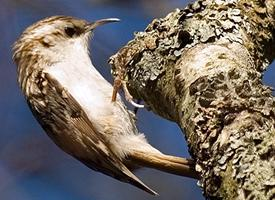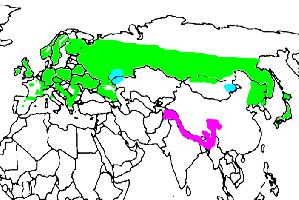
Descrierea animalului
The Eurasian Treecreeper, scientifically named Certhia familiaris, is a small, inconspicuous bird that is a master of camouflage and an expert climber, primarily found across the forests of Europe and parts of Asia. This diminutive bird, measuring about 12 to 14 centimeters in length and weighing between 7 to 12 grams, boasts a remarkably cryptic plumage that allows it to blend seamlessly into the bark of trees, making it a challenge for predators and birdwatchers alike to spot.The Eurasian Treecreeper has a slender, down-curved bill that is perfectly adapted for probing into crevices in the bark to extract its prey, primarily consisting of insects and spiders. Its upperparts are mottled brown and black, resembling the pattern of tree bark, while its underparts are a contrasting white or pale buff, providing excellent camouflage against predators from both above and below. The bird's tail is stiff and acts as a support brace while it ascends tree trunks in a spiral manner, reminiscent of a mouse scurrying up a tree, hence its alternative name, the "tree mouse."
One of the most distinctive features of the Eurasian Treecreeper is its unique method of locomotion. Unlike woodpeckers that hop up tree trunks, treecreepers ascend in a helical fashion, using their strong legs and curved claws to cling to the bark, and their stiff tail feathers for support. This spiral ascent allows them to meticulously inspect every crevice for food, making them incredibly efficient foragers.
The Eurasian Treecreeper is a resident bird in many of its habitats, though northern populations may migrate southwards during the harsher winters. It is a solitary bird for most of the year, coming together with a mate only during the breeding season. The birds are monogamous, and they construct their nests behind loose bark or in crevices of tree trunks. The nest itself is an intricate construction of twigs, moss, and spider webs, shaped to fit the chosen nook perfectly. The female lays between 5 to 6 eggs, which are white with reddish speckles, and both parents share the responsibility of incubation and feeding the chicks.
The song of the Eurasian Treecreeper is a delicate, high-pitched trill, often described as a "see-see-see," which can be heard throughout its habitat, adding a layer of auditory beauty to the forests it inhabits. Despite its presence being more often heard than seen, the Eurasian Treecreeper plays a vital role in the ecosystem by controlling insect populations and acting as an indicator of forest health.
In summary, the Eurasian Treecreeper (Certhia familiaris) is a fascinating example of adaptation and survival in the avian world. Its cryptic plumage, unique foraging behavior, and the role it plays in the ecosystem make it a subject of interest for birdwatchers and ecologists alike. Despite its small size and elusive nature, the Eurasian Treecreeper has a significant presence in the forests of Europe and Asia, embodying the complexity and interconnectedness of nature.
Harta răspândirii

Fotografii noi cu animale
Top 10 animale
- Dolphin gull (Leucophaeus scoresbii)
- Diana monkey (Cercopithecus diana)
- Moustached guenon (Cercopithecus cephus)
- Galápagos tortoise (Geochelone nigra complex)
- Stone loach (Barbatula barbatula)
- Greek tortoise (Testudo graeca)
- Japanese macaque (Macaca fuscata)
- Russian tortoise (Testudo horsfieldii)
- Common flying dragon (Draco volans)
- Galápagos penguin (Spheniscus mendiculus)